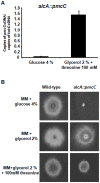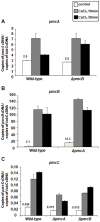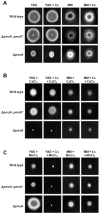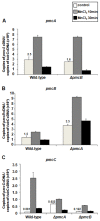Functional characterization of an Aspergillus fumigatus calcium transporter (PmcA) that is essential for fungal infection
- PMID: 22649543
- PMCID: PMC3359301
- DOI: 10.1371/journal.pone.0037591
Functional characterization of an Aspergillus fumigatus calcium transporter (PmcA) that is essential for fungal infection
Abstract
Aspergillus fumigatus is a primary and opportunistic pathogen, as well as a major allergen, of mammals. The Ca(+2)-calcineurin pathway affects virulence, morphogenesis and antifungal drug action in A. fumigatus. Here, we investigated three components of the A. fumigatus Ca(+2)-calcineurin pathway, pmcA,-B, and -C, which encode calcium transporters. We demonstrated that CrzA can directly control the mRNA accumulation of the pmcA-C genes by binding to their promoter regions. CrzA-binding experiments suggested that the 5'-CACAGCCAC-3' and 5'-CCCTGCCCC-3' sequences upstream of pmcA and pmcC genes, respectively, are possible calcineurin-dependent response elements (CDREs)-like consensus motifs. Null mutants were constructed for pmcA and -B and a conditional mutant for pmcC demonstrating pmcC is an essential gene. The ΔpmcA and ΔpmcB mutants were more sensitive to calcium and resistant to manganese and cyclosporin was able to modulate the sensitivity or resistance of these mutants to these salts, supporting the interaction between calcineurin and the function of these transporters. The pmcA-C genes have decreased mRNA abundance into the alveoli in the ΔcalA and ΔcrzA mutant strains. However, only the A. fumigatus ΔpmcA was avirulent in the murine model of invasive pulmonary aspergillosis.
Conflict of interest statement
Figures









Similar articles
-
ChIP-seq reveals a role for CrzA in the Aspergillus fumigatus high-osmolarity glycerol response (HOG) signalling pathway.Mol Microbiol. 2014 Nov;94(3):655-74. doi: 10.1111/mmi.12785. Epub 2014 Sep 30. Mol Microbiol. 2014. PMID: 25196896
-
Functional characterization of the Aspergillus fumigatus calcineurin.Fungal Genet Biol. 2007 Mar;44(3):219-30. doi: 10.1016/j.fgb.2006.08.004. Epub 2006 Sep 20. Fungal Genet Biol. 2007. PMID: 16990036
-
Functional characterization of the Aspergillus fumigatus CRZ1 homologue, CrzA.Mol Microbiol. 2008 Mar;67(6):1274-91. doi: 10.1111/j.1365-2958.2008.06122.x. Epub 2008 Feb 20. Mol Microbiol. 2008. PMID: 18298443
-
Genes and molecules involved in Aspergillus fumigatus virulence.Rev Iberoam Micol. 2005 Mar;22(1):1-23. doi: 10.1016/s1130-1406(05)70001-2. Rev Iberoam Micol. 2005. PMID: 15813678 Review.
-
Aspergillus fumigatus metabolism: clues to mechanisms of in vivo fungal growth and virulence.Med Mycol. 2009;47 Suppl 1(Suppl 1):S72-9. doi: 10.1080/13693780802455313. Epub 2009 Feb 27. Med Mycol. 2009. PMID: 19253141 Free PMC article. Review.
Cited by
-
Synergistic Antifungal Effect of a Combination of Iron Deficiency and Calcium Supplementation.Microbiol Spectr. 2022 Jun 29;10(3):e0112122. doi: 10.1128/spectrum.01121-22. Epub 2022 Jun 8. Microbiol Spectr. 2022. PMID: 35674440 Free PMC article.
-
Calcineurin Regulates Conidiation, Chlamydospore Formation and Virulence in Fusarium oxysporum f. sp. lycopersici.Front Microbiol. 2020 Oct 22;11:539702. doi: 10.3389/fmicb.2020.539702. eCollection 2020. Front Microbiol. 2020. PMID: 33193126 Free PMC article.
-
Different Stress-Induced Calcium Signatures Are Reported by Aequorin-Mediated Calcium Measurements in Living Cells of Aspergillus fumigatus.PLoS One. 2015 Sep 24;10(9):e0138008. doi: 10.1371/journal.pone.0138008. eCollection 2015. PLoS One. 2015. PMID: 26402916 Free PMC article.
-
The Vacuolar Ca2+ ATPase Pump Pmc1p Is Required for Candida albicans Pathogenesis.mSphere. 2019 Feb 6;4(1):e00715-18. doi: 10.1128/mSphere.00715-18. mSphere. 2019. PMID: 30728284 Free PMC article.
-
Calcineurin as a Multifunctional Regulator: Unraveling Novel Functions in Fungal Stress Responses, Hyphal Growth, Drug Resistance, and Pathogenesis.Fungal Biol Rev. 2014 Oct;28(2-3):56-69. doi: 10.1016/j.fbr.2014.02.004. Fungal Biol Rev. 2014. PMID: 25383089 Free PMC article.
References
-
- Fox DS, Heitman J. Good fungi gone bad: the corruption of calcineurin. Bioessays. 2002;24:894–903. - PubMed
-
- Cyert MS. Calcineurin signaling in Saccharomyces cerevisiae: how yeast go crazy in response to stress. Biochem Biophys Res Commun. 2003;311:1143–1150. - PubMed
-
- Steinbach WJ, Reedy JL, Cramer RA, Perfect JR, Jr, Heitman J. Harnessing calcineurin as a novel anti-infective agent against invasive fungal infections. Nat Rev Microbiol. 2007;5:418–430. - PubMed
Publication types
MeSH terms
Substances
LinkOut - more resources
Full Text Sources
Molecular Biology Databases

